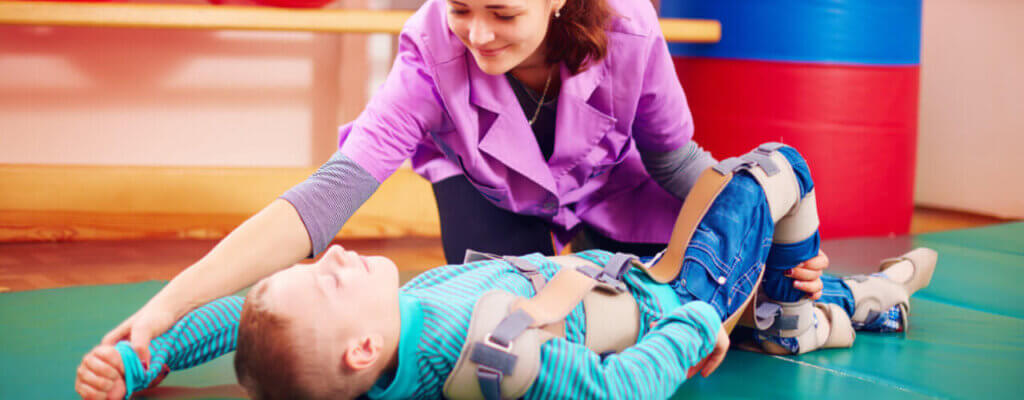If your child has been diagnosed with Muscular Dystrophy, the diagnosis probably answered your questions about their struggles with motor development. While this was most likely a relief for you, understanding your child is living with a condition like MD may have also presented a new level of concern where physical therapy can provide you with some help.
According to the National Institutes of Health, over 30 types of muscular dystrophy. To make the diagnosis even more complicated, many diseases look similar and may initially be mistaken for muscular dystrophy, e.g., mitochondrial disorders.
A complete medical assessment with genetic testing can determine MD or a related disorder. Depending on the type of MD, the prognosis and treatment strategies may differ.
Duchenne muscular dystrophy (DMD) accounts for 50 percent of all cases, making it the most common. DMD is an X-linked mutation and therefore affects males more seriously. Females who carry the mutation may have some mild symptoms.
Suppose you are facing a diagnosis of muscular dystrophy in your child. In that case, it is never too early to contact a pediatric physical therapist to learn more about the modes of support available to you! Mark Their Words Therapy Services in Clarksville’s therapists are available and ready to assist you and your child.
Symptoms of muscular dystrophy in children
Parents are the first to see and acknowledge movement dysfunction in their children. Once a concern arises, it is sometimes difficult to know the next step. Here are some basic questions to help parents move through the process.
- Is your child meeting developmental milestones?
- Is your child losing skills they’ve already acquired?
- Is your child having difficulty keeping up with siblings or peers on the playground?
If any of these are of concern, the first step is for your pediatrician to start the referral process for diagnostics and physical therapy.
If you suspect DMD in particular, some early signs to consider are:
DMD causes the following issues:
- Falls
- Difficulty walking and running
- Enlarged calf muscles
- Cardiac and respiratory compromise
- Eventual loss of independent ambulation
Again, if you have concerns, your pediatrician can help you access specialists, including a physical therapist.
How can a pediatric physical therapist help with muscular dystrophy?
Pediatric physical therapy can be the first step in helping your child gain better access to their world. Early intervention by physical therapy can help slow the progression of DMD by providing the child and family with exercises and energy conservation strategies.
Physical therapists can work with durable medical equipment providers and orthotists to fit your child for supportive bracing and assistive devices. They can also consult with you on home modifications to make your home more accessible and safe for your child.
What works in the first years of life for a child with DMD will not be the same as they grow older and bigger. Establishing a good working relationship with a physical therapist early on will make the journey with DMD easier to manage as the therapist will know your child and family.
There are many forms of physical therapy intervention for individuals with DMD. Stretching programs and the use of orthotics can help prevent contractures. Aquatic physical therapy can provide an excellent and freeing experience for patients with DMD. The water provides a supportive environment for movement.
Physical therapists can also assist the child and family by working with the school staff, advocating for the family, and communicating with insurance companies. Physical therapists are vital members of the child’s care team, and physical therapy can help improve their abilities at any stage.
While the disease is among one of the most studied globally, there is still so much about muscular dystrophy that the scientific community doesn’t understand. There is no definitive cure, but emerging gene therapies and other hopeful interventions exist. Physical therapists are poised to keep up with the most current treatments and interventions to maximize function for your child with DMD.
Ready to get your child started on a treatment plan?
Pediatric physical therapy can be a tremendously helpful tool in the face of a muscular dystrophy diagnosis. Physical therapists are movement specialists. They are trained to look at the whole patient and maximize function. Your child deserves to live as fully as possible, regardless of their condition.
For more information, call Mark Their Words Therapy Services in Clarksville today and speak with our physical therapy team and schedule an evaluation for your child.
Sources:
- https://www.nichd.nih.gov/health/topics/musculardys/conditioninfo/types
- https://www.ninds.nih.gov/Disorders/Patient-Caregiver-Education/Hope-Through-Research/Muscular-Dystrophy-Hope-Through-Research
- https://rarediseases.info.nih.gov/diseases/6291/duchenne-muscular-dystrophy
Tags: Physical Therapy, Muscular Dystrophy, Physical Therapist, pediatric



